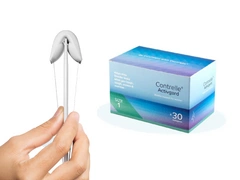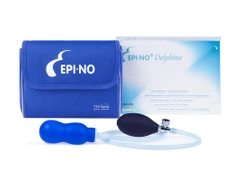Easy return of products
This product is available in our stores
EPI-NO birthing balloon
The EPI-NO Delphine Plus birthing balloon is an innovative device for antenatal training, the purpose of which is to prepare the perineum for childbirth, and thus reduce the risk of rupture or the need for an episiotomy during vaginal delivery.
EPI-NO is made of a narrowly profiled silicone balloon connected to a flexible tube with a hand pump and a display.
Training with a balloon to prepare for childbirth in the antenatal period gently stretches the pelvic floor muscles and prepares the entrance to the vagina. However, after giving birth, it will be an excellent solution for MDM training in order to regain the strength and efficiency of muscles weakened by pregnancy and childbirth.
EPI-NO Delphine Plus was developed in Germany by an obstetrician and midwives as a labor and pelvic floor exercise device.
The EPI-NO Delphine Plus balloon is a medical device.
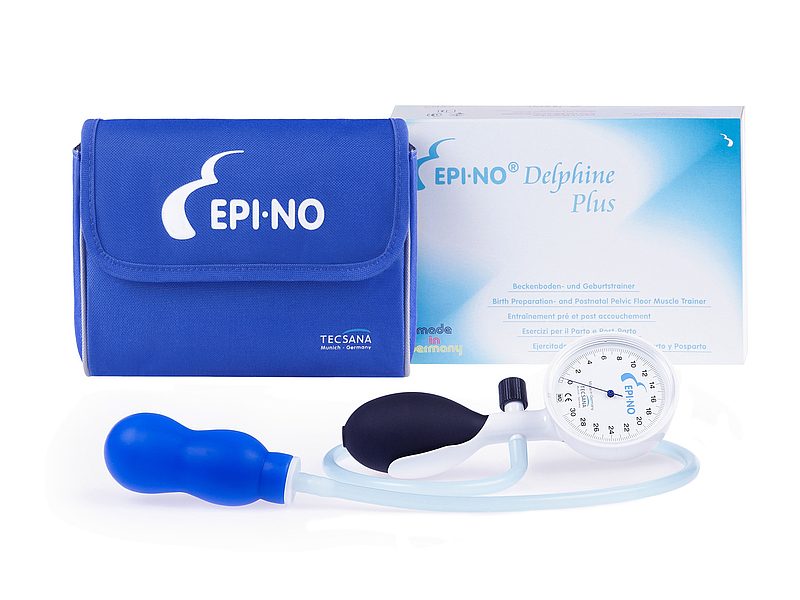
EPI-NO birthing balloon - a safe device with clinically proven effectiveness
The effectiveness of the birthing balloon was confirmed in clinical trials, which showed that the use of EPI-NO influenced:
- shortening the second stage of labor (1)
- a decrease in the episiotomy rate and, consequently, a reduction in the risk of complications after the incision (1, 4, 5)
- reducing the number of anesthetics administered (1)
- better neonatal APGAR scores (1)
- reducing fear of childbirth
- improving the condition of the pelvic floor muscles in postpartum training (3)
The use of a balloon is a safe method - In EPI-NO clinical trials, there were no indications of uterine contractions, cervical dilation or the risk of inducing labor (labor induction).
Preparation for childbirth with the EPI-NO balloon
Childbirth training to prepare the perineum for childbirth begins after the 36th week of pregnancy (3 weeks before the planned date of delivery). The balloon is gently inserted into the vagina for about two thirds of its length and inflates the perineum until personal comfort is achieved. They are performed gradually, in daily sessions lasting 20 minutes, consisting of several cycles of 5 minutes each. During these exercises, a balloon is inserted into the vagina and inflated.
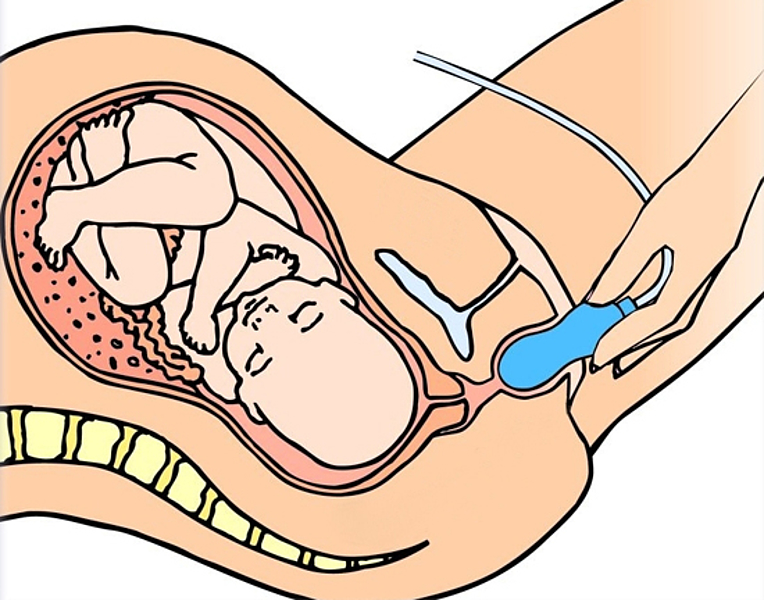
Optimal training is achieved when the balloon reaches a diameter of 8.5–10 cm and can be pushed out of the vagina once inflated. Pelvic floor muscle exercises. Pregnant women using EPI-NO usually achieve a dilation of 8.5 cm to 10 cm within 3-4 weeks. People who reach 8.5 cm will have an additional 1.5 cm at birth. After stretching exercises, the balloon can be gently pulled out, simulating a sense of control during labor itself.
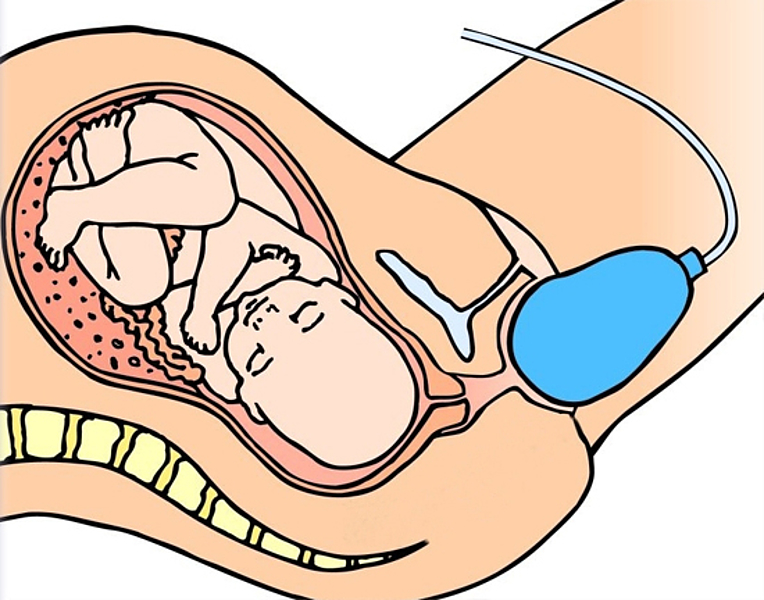
EPI-NO position after inflating to 10 cm after over 3 weeks of training.
EPI-NO balloon - doctor's opinion
“Pelvic floor training with the EPI-NO device is based on a therapy concept that has been known for many years (pelvic floor training against resistance using biofeedback). It is known from the literature that this form of pelvic floor therapy can be an effective and inexpensive form of treatment for urinary incontinence.”
Dr. Christian Dannecker, senior doctor in urogynecology. University of Munich, Germany.
“…Since the vast majority of women in our clinic use the Epi-No birthing trainer (it is also well advertised in pregnancy courses), the rate of cuts and major damage has dropped dramatically. This is becoming more and more common. that first-time mothers give birth with an intact perineum (even when giving birth to larger babies) and that tears are often relatively minor. I began to have difficulty training my physician assistants to treat birth injuries because they simply don't occur. First-time mothers especially benefit from this instrument, but it is certainly useful for subsequent pregnancies as well. For us, this tool is a bit of a revolution and we can highly recommend its use."
Dr. Peter Böhi, Head of Clinic for Gynecology and Obstetrics, Altstätten, Switzerland and resident gynecologist.
What is the EPI-NO balloon used for?
- Preparation for childbirth using a balloon - training with the EPI-NO balloon before childbirth can be started about 3 weeks before the planned date of delivery. Daily training should not be longer than 15-20 minutes. Training allows you to enlarge and stretch the perineum muscles.
- Strengthening the pelvic floor muscles using a balloon - move the balloon in different directions and rotate it around. The patient should also practice contracting and relaxing the muscles that hold the balloon in the vagina.
- Stretching the pelvic floor muscles - after placing the balloon in the vagina, inflate it gently so as not to cause discomfort. You can perform the exercises by keeping your legs together to prevent the balloon from falling out. The inflated balloon should remain in the vagina for about 10 minutes. Regularly performing this exercise allows you to gradually stretch the perineum muscles.
- Childbirth simulation - at the end of the antenatal training, the inflated balloon should be slowly removed from the vagina by pressing the muscles of the pelvic diaphragm. This simulates the passage of the baby's head through the birth canal.
- Getting back into shape after childbirth - Kegel training, which strengthens the pelvic floor muscles, restores their original flexibility, strength and tone. These exercises can be started about 3-6 weeks after giving birth after consulting a specialist.
Benefits of using the EPI-NO device:
- an easy-to-use home exercise device
- complementing the perineum massage in order to prepare for childbirth
- preparing the muscles of the reproductive tract for natural childbirth
- reduces the risk of perineal tears and episiotomy
- shortening the duration of the second stage of labor
- reduces the need to administer painkillers
- less stress for the woman giving birth and the baby in the second stage of labor
- acceleration of the regeneration process
- strengthens and tones the pelvic floor muscles
Contraindications to the use of a balloon
- in case of unusual position of the baby or in case of dangers related to performing tests that prevent vaginal delivery (e.g. placenta praevia)
- in case of risk of infection due to developing germs (e.g. premature rupture of membranes, vaginal infection)
- in the case of unhealed injuries in the genital area
- under the influence of alcohol and drugs
- in case of vaginal bleeding (genital tract)
- in the case of malignant diseases in the genital area (e.g. cervical cancer)
- EPI-NO Delphine and Delphine Plus may be used at the earliest three weeks before the estimated due date or as agreed with your doctor or midwife
- EPI-NO Delphine and Delphine Plus should not be used for more than two pregnancies, and also after the expiration date
- you should stop exercising with EPI-NO Delphine and Delphine Plus if you feel pain
Women can use EPI-NO Delphine and Delphine Plus only under the supervision of a doctor or midwife in the following cases:
- nerve damage and other diseases that limit the feeling of pain in the genital area
- transverse paralysis
- multiple sclerosis
- taking painkillers to reduce the feeling of pain in the vaginal area
- marked enlargement of the veins at the entrance to the vagina (varicose veins)
It is recommended that people consult with a healthcare professional before using EPI-NO to determine if EPI-NO is the right choice for their individual situation and medical history.
Contents of the package:
- EPI-No Deliphine Plus device with a pressure gauge and a hand pump
- storage case
- user manual
The product is not returnable for hygiene reasons.
- First clinical experiences with the new birth trainer Epi-no® in primiparous women J. Hillebrenner, S. Wagenpfeil*, R. Schuchardt, M. Schelling, K.T.M. Schneider , Department for Obstetrics and Gynecology of the Technical University of Munich, Institute for Medical Statistics and Episiotomy
- Birth preparation with a novel birth training device, R. Schuchardt, J. Hillebrenner, S. Hoffmann, W. Horkel*, M. Schelling, KTM Schneider, Frauenklinik der TU-München; Klinikum rechts der Isar, Abteilung für Perinatalmedizin; * Praxis Starnberg
- Increase in the efficiency of postpartum pelvic floor training using the EPI-NO trainer, Irini Papadopoulou, midwife, Ottobrunn, December 2002
- Prospective randomised multicentre trial with the birth trainer EPI-NO® for the prevention of perineal trauma Eugen RUCKHÄBERLE, Katharina JUNDT, Martin BÄUERLE, Karl-Heinz BRISCH, Kurt ULM, Christian DANNECKER and Karl Theo Mario SCHNEIDER
- First Australian trial of the birth-training device Epi-No: A highly significantly increased chance of an intact perineum, Gabor T. KOVACS, Penny HEATH and Campbell HEATHER 2














